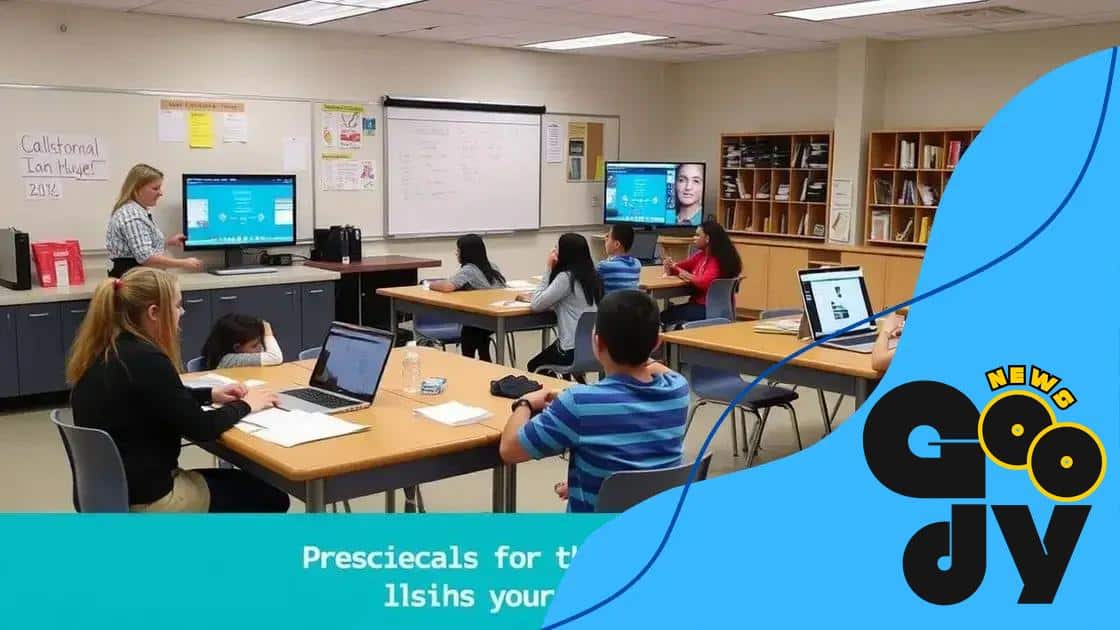Hybrid learning models and outcomes: transforming education

Hybrid learning models combine in-person and online instruction, enhancing flexibility and collaboration while addressing challenges like technology access and student engagement through effective strategies.
Hybrid learning models and outcomes are changing the way we approach education today. Have you ever wondered how these innovative strategies can lead to better learning experiences? Let’s dive into this exciting topic.
what are hybrid learning models?
Hybrid learning models combine traditional face-to-face instruction with online learning, creating a flexible educational approach. This model allows students to engage in both in-person classes and remote learning activities, catering to diverse needs and learning styles.
Types of hybrid learning models
There are various ways to implement hybrid learning.
- Flipped classrooms: Students learn new content online and gain understanding during in-person sessions.
- Rotation models: Learners alternate between in-person and online classes, enhancing their educational experience.
- Flex models: Students have the freedom to choose when and how they learn, balancing their preferences and schedules.
These models not only provide flexibility but also promote self-directed learning. By integrating technology, educators can encourage students to take charge of their education. It can be exciting to discover how hybrid models can support individual learning journeys. Additionally, hybrid learning fosters collaboration among students, whether they are working digitally or together in a classroom.
Benefits of hybrid learning
Implementing hybrid learning models offers numerous advantages.
- Enhanced accessibility: Students can learn from anywhere, making education more inclusive.
- Personalized learning: This approach allows learners to progress at their own pace, addressing unique needs and challenges.
- Improved engagement: The blend of online and offline resources keeps students interested and motivated.
As education continues to evolve, understanding hybrid learning models helps students and educators adapt. By embracing this approach, we prepare ourselves for a future filled with opportunities for everyone.
benefits of hybrid learning for students
Hybrid learning offers many benefits that can greatly enhance a student’s educational experience. This model combines the best of both in-person and online learning environments.
Increased flexibility
One major advantage is the increased flexibility it provides. Students can choose where and when to learn, allowing them to balance school with other commitments. This flexibility promotes a better learning pace.
- Self-paced learning: Students can revisit materials as needed, reinforcing understanding.
- Diverse resources: Access to a wide range of online tools and content makes learning more engaging.
- Personalized education: Tailoring lessons to individual needs often results in a more effective learning experience.
By engaging with material in various ways, students are more likely to retain information. This approach helps develop essential skills such as critical thinking and time management.
Enhanced collaboration
Another key benefit of hybrid learning is the enhancement of collaboration among peers. Students can work together on projects, whether they meet in person or interact through online platforms. This collaborative atmosphere encourages social learning.
- Peer feedback: Working with others allows for valuable feedback and diverse perspectives.
- Global connections: Students can connect with peers from around the world, enriching their understanding of different cultures.
- Effective teamwork: Skills developed during group projects are valuable for future careers.
This blend of independence and collaboration prepares students for the ever-evolving workforce. Overall, hybrid learning represents an exciting opportunity for students to thrive in their educational journey.
best practices for implementing hybrid models

Implementing hybrid models in education can be highly effective with the right strategies. This approach requires thoughtful planning to ensure that both in-person and online components align well.
Establish clear goals
Begin by setting clear objectives for the hybrid learning experience. Having defined goals helps guide decisions about technology, content, and assessments. Every participant should know what is expected from them and how they can achieve success.
- Identify learning outcomes: Specify what students should learn and accomplish through the hybrid model.
- Align teaching methods: Match teaching practices with the learning goals to create consistency.
- Evaluate progress frequently: Regular assessments keep everyone accountable and informed.
Effective communication between students and educators is vital in a hybrid model. Ensuring that everyone is on the same page fosters a supportive learning environment. Providing channels for feedback and discussion is essential.
Utilize technology effectively
The right technology can make or break a hybrid learning model. Choose tools that facilitate interaction and enhance the learning experience. Training for both instructors and students on how to use these tools is crucial for success.
- Learning management systems: Implement a platform that organizes resources and tracks student progress.
- Interactive software: Use tools that promote collaboration, such as video conferencing and online discussion boards.
- Adaptive learning technologies: These tailor the learning experience based on individual student needs.
By fostering an adaptable learning atmosphere, hybrid education becomes not just a trend, but a transformative approach that can cater to diverse learning styles. Finally, it’s important to gather feedback from participants to continuously improve the hybrid model and ensure it meets everyone’s needs.
measuring outcomes in hybrid education
Measuring outcomes in hybrid education is essential to understand its effectiveness. It provides insights into how well students are learning in both online and in-person environments.
Establish clear evaluation criteria
First, it’s important to set specific criteria for evaluation. This includes defining what success looks like in both settings. Establishing these guidelines informs educators and students about goals and expectations.
- Academic performance: Track grades and assessment scores to gauge knowledge retention.
- Engagement levels: Use surveys to measure student participation and interest in the learning process.
- Skill development: Assess improvements in critical thinking, collaboration, and time management skills.
Collecting data on these criteria helps in identifying strengths and areas for improvement, enabling effective adjustments to teaching strategies.
Utilize diverse assessment methods
Using various assessment methods is crucial. This can include traditional tests, project-based assessments, and digital portfolios. Incorporating different types of evaluations allows educators to get a comprehensive view of student learning.
- Formative assessments: Regular quizzes and assignments help track progress throughout the course.
- Summative assessments: Final exams and major projects assess knowledge at the end of a learning unit.
- Peer assessments: Allow students to evaluate each other’s work, fostering collaboration and critical thinking.
The right mix of assessments enables educators to understand how effectively the hybrid model fulfills educational goals. Continuous feedback is vital in this process, guiding both educators and students towards improvement.
challenges and solutions in hybrid learning
Implementing hybrid learning comes with its unique challenges. Understanding these obstacles is the first step toward developing effective solutions.
Technology issues
One major challenge is the reliance on technology. Students and teachers may face technical difficulties, such as poor internet connection or unfamiliarity with digital tools. These issues can hinder the learning experience.
- Access to devices: Not all students have equal access to computers or tablets, leading to disparities.
- Technical support: Lack of immediate tech support can frustrate users when problems arise.
- Training: Both students and teachers need adequate training to use online platforms effectively.
By addressing these technology-related challenges, schools can create a more equitable learning environment for everyone.
Student engagement
Another challenge is maintaining student engagement. In a hybrid model, some students may feel disconnected during online lessons, affecting their motivation.
- Interactive content: Incorporating videos, quizzes, and discussions can help keep students focused.
- Frequent check-ins: Regular online meetings help educators monitor engagement and offer support.
- Peer collaboration: Group activities encourage teamwork and interaction among students.
Finding ways to engage all students is crucial for the success of hybrid learning.
Assessment difficulties
Assessing student performance in a hybrid setup can be tricky. Educators must ensure evaluation methods are fair and effective for both in-person and online learners.
- Varied assessments: Using a mix of tests, projects, and presentations caters to different learning styles.
- Transparent criteria: Clearly defined grading rubrics help students understand expectations.
- Feedback loops: Regular feedback is essential to guide improvement and motivation.
By implementing these strategies, schools can address the challenges of hybrid learning and promote a more effective educational experience.
In summary, hybrid learning offers an innovative approach to education that blends in-person and online experiences. While it presents certain challenges, such as technology access and student engagement, effective strategies can help overcome these barriers. By establishing clear objectives, utilizing technology wisely, and focusing on assessment methods, educators can create a successful hybrid learning environment. As we move forward, continuous adaptation and improvement will be vital to ensure all students thrive in this new educational landscape.
FAQ – Frequently Asked Questions about Hybrid Learning Models
What is hybrid learning?
Hybrid learning combines in-person and online instruction to create a flexible learning environment for students.
What are the main benefits of hybrid learning?
It offers increased flexibility, personalized learning experiences, and enhanced collaboration among students.
What challenges might educators face with hybrid learning?
Common challenges include technology access issues, maintaining student engagement, and assessing student performance accurately.
How can schools overcome these challenges?
Schools can provide training on technology, use diverse assessment methods, and foster open communication to enhance engagement.





